Chatham Fire Department
Village of Chatham
Report of Chief Eric Barnes
March 2021
State of the Department
Introduction
This report is intended to document the current State of the Chatham Fire Department, the major factors underlying operation of the department, the main issues currently facing the department, consideration of the department’s needs in the future and to make recommendations and anticipated steps the department is required to provide to serve the public safety needs of our community presently, as well as into the immediate future.
The report will consider not only the hard/physical assets of department but significantly, the human aspect as well, including potential recruitment, safety, health and morale issues facing our volunteers
The report is divided into 5 main parts
– Manpower/Volunteers
– Facilities – The Chatham Fire Station
– Apparatus
– Equipment
– Shared Services and Consolidation
The needs of the department, village, department membership and the community at large are considered and, to the fullest extent possible, the on-going costs of maintaining the status quo vs. upgrading our assets for the future good and life of the department
To the best of our knowledge, the report and documentation contained within this report is likely the most comprehensive report on the State of the Department that the Village of Chatham administration has ever seen. The information contained within comes from months of research, meetings with consultants, years of experience and review of records maintained by CFD
The opinions contained within are those of the Chief alone unless specifically stated but are made in consultation with various stakeholders and with the best interests of the CFD, the VOC and the greater Chatham community at large in mind
In the end, all issues and suggested resolutions should be approached with caution, as it is the ultimate opinion of the Chief that the entire Village undergo a Master Plan review. Specifically, the emergency services of the Village should consider a thorough review to ensure the most beneficial services are being provided for the costs that are borne by taxpayers
The main part of this presentation is designed to heighten your awareness to the issues and challenges. For more specific details and additional information, there are links to appendices which are at the end of the presentation n
Key Challenges And Issues Facing The Department
- Manpower/Volunteers
- Facilities – The Chatham Fire Station
- Apparatus
- Equipment
- Shared Services and Consolidation
- Recommendations regarding these issues are at the end of the last section
Manpower/Volunteers
- CFD is comprised of approximately 50 dedicated members of the community
- ~36 are active – 4Of those, approximately 18 are Class A (interior) FF’s
- Membership is comprised of all walks of life from within and around the village
- We are residents, business owners, retirees, teachers, DOT workers etc.
Recruitment
- We live here, we raise our families here, we work here, we go to school here
- Recent campaign – mailers to 1600 community residences protected by CFD
- Email [email protected] to receive a copy if you haven’t already
Key Accomplishments
- The Department responds to an average of 120 alarms per year (based on FY’s 2015-2020)
- The average number of members responding to an alarm is 15.5
- In the past 2 years four volunteers of the CFD have been named County, Region and State Firefighters of the Year
- CFD obtained the Insurance Services Office (ISO) Classification 3, the highest classification in Columbia County resulting in possible insurance premium reductions for residents
- In 2018, thanks to a couple of dedicated members, assistance from community members and some really good fortune, CFD’s extraordinary recruitment campaign was recognized by the Firemen’s Association of the State of New York (FASNY) as the “BEST” in New York State in 2020
- CFD has the highest recruitment percentage of any department in the county
- The volunteer membership of the CFD is the heart and soul not only of the department, but of our community
BUT
Quite possibly…..Our largest ‘liability’ is our membership!
It Takes A Village
- Maintaining a functional volunteer fire department will require continued collaboration.
- A local study in 2005 estimated the cost of 24 paid firefighters in Chatham would cost the Village approximately $3 Million annually
- Economic Study: Volunteer Firefighters Save NY Taxpayers More than $3 Billion Each Year | FASNY
- The fire companies and the village board, as well as other elected officials will need to continue to work together to combat the issue of recruitment and retention
- Retention is a key issue. In the past 2 years, CFD has seen a loss of approximately 50% of all newly recruited members since the beginning of our campaign drive
- Retention issues are most commonly due to factors outside of our control (change in family status, moving from the area, joining the armed forces, etc.)
- How can we retain the others? An on-going discussion and challenge!
– The Village, along with the two fire companies, should continue their financial support of the on-going recruitment campaign and institute modest retention policies
Benefits Of Volunteering
- NYS Cancer Fund (life insurance for interior firefighters)
- $200 tax credit
- Comradery/sense of ‘doing something good for our community’
- NYS offers educational financial aid for volunteers
- Length of Service Award (LOSAP)? Is it affordable? Does it work?
– A form of pension paid at a certain age
– Requires financial commitment from the Village
– Not clear of the benefit to younger members who might not be here long enough to reach the age at which benefits would be paid
Facilities – The Chatham Fire Station

Goals Of The Facilities Report
- Identify needs of the Department, Village, membership and community at large
- Identify current costs of maintaining and repairing current station
- Identify potential safety, health, and morale issues to volunteers
- Pros/cons of doing nothing – keeping existing structure vs. renovation vs. new construction
Description of the Fire Station at 10 Hoffman St.
- The Chatham Fire House, aka the fire station
- Constructed in 1971
- Insulated steel sided, steel I-beam span building
- 5 apparatus bays facing Hoffman St. for large trucks
- 2 smaller bays facing Hudson Ave
- 2 small offices
- 1 large banquet hall and kitchen
- 2 small restrooms marked female and male
- 1 meeting / member’s room
Needs Of The Village And The Community At Large
- Receiving professional and expedient fire and rescue response
- CFD to provide fire protection to prevent loss of life and property
- Well-run volunteer fire brigade with utmost fiscal responsibility
- A physical structure that is safe 4One that can maintain this necessary brigade and keep it always at the ready
– One that can be utilized for safe haven in the event of a disaster •Warming center / shelter / cooling center / supply distribution - One that can be used by our stakeholders for important community functions •Meetings / fundraisers / blood drives
Safety and Health Issues – To Name Just A Few
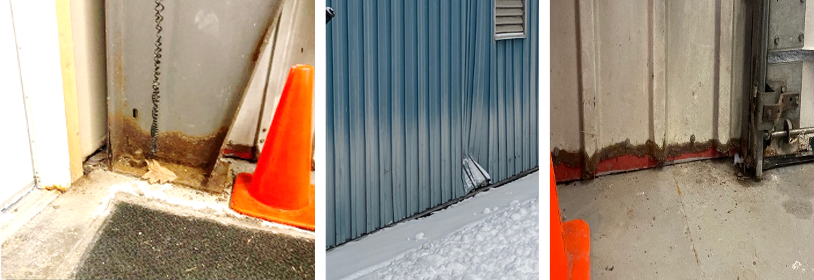
- Rusted and corroded structural components
– Support beams rusted and corroded
– Siding rusted and damaged - Outdated electrical components and supply
- Aging and outdated heating system
– Fuel oil stored within the structure - Dangerous condition from snow falling off the roof
– We have already sustained property damage to our entry way as well as the shed roof over the generator. This is even more of a problem today. Once again we had snow and ice come off. I have had discussions with the mayor today as it tore some of the cable lines out of the roof again. This happens every year. - Ice accumulation in the parking lot poses liability issues
– Serious substrate flaws beneath the blacktop
– Deep standing pools of water - Air compressor noise and fumes
- Poor facilities for gear storage
– gear stored in close proximity to the diesel exhaust of the apparatus
– Possible contamination by diesel fumes and particulates

The Kitchen
- Aging kitchen appliances pose a potential fire hazard
- The kitchen lacks a range hood with a modern fire suppression system
- The kitchen should be demolished, remodeled and refit with modern appliances
- This would encourage outside entities to use or rent our facilities to generate revenue
- This would also bring the kitchen up to OSHA and Department of Health standards

ADA Compliance
- The bathrooms do not meet current ADA requirements
- It is difficult for wheelchair / handicapped persons to navigate and are nearly impossible to use if you are handicapped
- Bathrooms need to be reconfigured and upgraded to be made ADA compliant
- Currently difficult to maintain
– Floor and wall surfaces need to be replaced
– Nearly impossible to properly sanitize due to age and inherent porosity
Cost To Maintain Current Structure
- In 2021 $8500 is budgeted for heating oil
- $4500 is budgeted for electricity
- $11,000 is budgeted for building repair and maintenance
– $9000 is for annual repairs
– $500 for heating system repairs
– $800 for generator maintenance
– $700 for overhead door maintenance
Issues For Discussion – Repair/Maintain vs. Build Anew
- Without a complete thorough study by an Engineer or Consultant, estimations would be guesswork at best
– Cost of full renovation of rusted-out steel siding is unknown
– Previous engineers have identified major structural deficiencies in structural steel
– Other than minor cosmetic improvements and roof repair there have been no major improvements or renovations to the 50-year-old structure itself - How long can the building be maintained (and at what cost) and still be useable?
- Renovation of interior
– Ensure OSHA/PESH compliance
– Ensure ADA compliance - Heating and cooling efficiency
– New windows and doors
– Insulation. - Stations built in Columbia County over the past 10+ years have ranged from $800,000 to $1.5 Million
– With inflation and construction labor and materials increases, the cost for replacement is perceived to be anywhere from $2.5 – $5 million
– But in the long run, will the savings from a new structure (reduced liability, health, safety, morale, maintenance and repair) prove to be worth the substantial investment required?
Apparatus
Goals Of The Apparatus Report
- Document current fleet
- Identify needs of the Department regarding apparatus usage
- Identify potential maintenance issues with existing apparatus
- Identify cost vs. benefit of keeping existing apparatus vs. purchase of new apparatus.
- Identify resale value of apparatus
Current Department Apparatus
- The Department operates the following apparatus:
– One 1993 Engine (58-21)
– One 2016 Engine (58-22)
– One 1994 Brush Truck (Engine 58-66)
– One 1997 Rescue Truck (58-46)
– One 2011 Ladder Truck (Ladder 58-51)
– One Gator (58-60) and Trailer (new in 2020)
– One Fire Police van (58-74, donated, problematic, currently out of service)
– Average age of the fleet: 18 years - All 3 Fire Chiefs currently operate and respond to calls in personal vehicles
LADDER 58-51
- 75-foot aerial ladder
- Ground ladders
- Water tank
- Hoses
- Pump
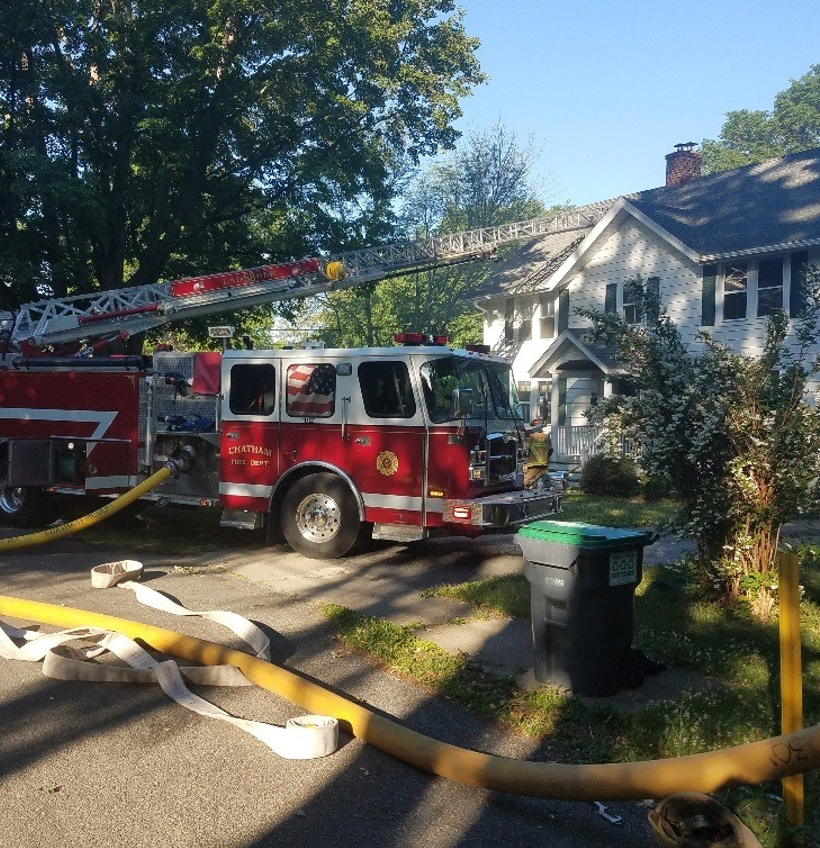
Summary of Issues and Needs
- New apparatus needs
– Command Vehicle / Specialty Use Vehicle / Chief’s Car to replace use of POV (Personally Owned Vehicle)
– Purchase of single replacement rescue-engine to replace two pieces of aging apparatus (Engine 58-21 and Rescue 58-46 – combined age over 50 years) - Benefits of disposal of two pieces of aging apparatus and replacing with one
– Cheaper to maintain
– Increases driver pool
– Reduces training requirements
– Reduces time spent on equipment checks
Recommendation To Purchase A Command Vehicle
- The Village of Chatham maintains a policy of Chiefs utilizing POV’s
Chiefs operate, fuel and maintain their POV’s:
– To respond to emergency calls for service
– Transport emergency equipment such as 58-60 (Gator) and trailer
– To travel to meetings and training and to conduct department and village business
– To transport members and run errands for the Village and Fire Protection Districts - E.g., on 2/5/21 Car 1 (Chief) travelled to Kingston in order to transport the ladder truck to the dealer for service. Also, on a recent fire alarm at night, Car 2 arrived at a dark house, only to find a scared homeowner who did not recognize that it was the Fire Chief pulling into their driveway
- In 163 years, the demands and liabilities on Fire Chiefs have exponentially increased!
– Calls for service, meetings, trainings etc. have all increased
– Morale…… Although hard to quantify, it is costly!
– Potentially, more importantly, Safety and Liability:
– Certainly, we would all agree that our law enforcement officers, responding to an emergency in their own POV, would increase liability, dimmish the gravity of an emergency situation and furthermore, civilians involved may not respect or obey directives or orders if they question authority when your status is in doubt (i.e., responding in POV)
– In this litigious society that we live in, what is the liability of the Village? - Shouldn’t our volunteer leaders be afforded the same protection and safety that other emergency service agencies receive?
Local Departments With Command Vehicles
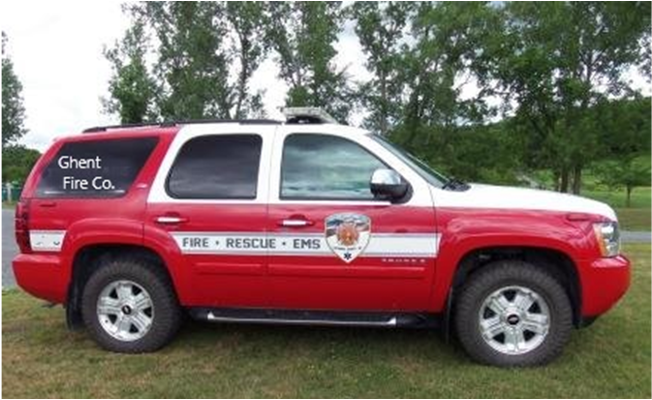
- Most districts and departments have recognized, due to liability and increased workload, the importance of Chief officers having a command vehicle in order to effectively run a department
– Ghent Fire Company
– Red Rock Fire Department
– Village of Kinderhook
– Village of Philmont
– City of Hudson
– Greenport Fire District
– Tri-Village Fire Department
– Niverville Fire Department - These vehicles are commonly used to carry various pieces of equipment (air paks, fire extinguishers, rescue equipment, spare radios, accountability equipment for member safety, etc.) and can serve as a quick response vehicle
- Potential cost
– $10,000 – $25,000 used
– Similar cost as mid-high end SUV new
Current Problem Areas Regarding Existing Fire Apparatus
- Increased costs of maintaining and repairing multiple vehicles
- Age of current vehicle fleet
- Reliability of aged apparatus
- Lack of available manpower for staffing purposes; getting more than one unit on the street for an alarm
- Lack of qualified operators for multiple vehicles and the additional training requirements required to operate multiple units
Proposed Course of Action
- After discussion and consultation with the team of Chiefs, we have agreed that the following course of action would be the best way forward:
– Dispose of the current Engine 58-21 and Rescue 58-46
– Consolidate the roles and equipment of both vehicles into one multi-purpose vehicle - Morale
– Maintaining up to date apparatus has far reaching effects….possibly more important than the financial impact!” - Fringe benefit
– In 2013 CFD saw a surge in membership and response percentage. This was the year following the purchase of the first new piece of apparatus since 1998!
– In 2017 CFD saw another surge in participation and new membership…again this was the year following the purchase of a new engine that replaced a 1988 engine!
Disposition of Engine 58-21
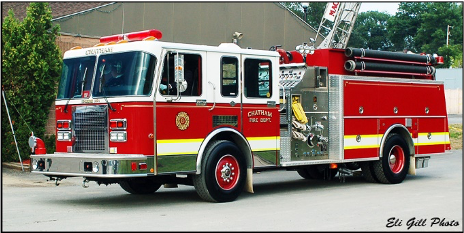
- Engine 58-21 41993 KME Body/Spartan Gladiator Chassis
– Purchased 2nd hand from the Middle Hope Fire Department (Newburgh Area)
_ 2000 the transmission was rebuilt W&W transmission
– 2003 the engine was rebuilt by Eagle diesel
– 2005 The hale pump was replaced by Garrison fire equipment - Potential future maintenance items:
– Water Tank: The water tank is constructed of untreated steel
– Aging corroded steel frame
– Aging / failing electrical system - Obtaining parts for maintenance on a 30-year-old truck is difficult
Disposition of Rescue 58-46

- 1997 International 4700 Chassis/Saulsbury Body
- Carries rescue Tools / Generator / Cascade system (mobile air supply)
- Does not carry water, hoses, or a pump
- By its nature, there are less moving and wearing parts on a rescue vehicle
- The body is steel and stainless steel
Current Annual Vehicle Operating Costs On The Two Apparatus
- Insurance
– We were not able obtain this information - Fuel
– $800 (est.) - Preventative Maintenance
– $1,800 - Pump Testing
– $821 -$1000 - Repairs/Maintenance Costs over 5 years
– $13,555
– This figure is based on the information available at time of report. It does not include incidentals such as ball valve repairs, light replacements etc. - Currently the vehicles have insurance coverage at value costs, not replacement costs
– Rescue coverage, $90,000.00
– Engine Coverage, $80,000.00
– Unfortunately, these coverages would not be sufficient should we need to replace either vehicle due to catastrophic failure or accident.
Cost Of New Apparatus
- The delivered cost of any new equipment depends not only on the “base” price of the vehicle but can increase substantially depending on the various supplementary items that may be included (scene lights, generator, cascade/air supply, pump capacity, water capacity, foam capacity, etc.)
- Here are two examples of apparatus costs just to show the general range
– Our engine 58-22 purchased in 2016: $386,466
– Ghent’s tanker purchased in 2020: $422,000
– In 2020, the cost of a tanker (a much simpler vehicle than an engine) was more than 9% higher than that of an engine purchased 4 years earlier
– Equipment vendors have indicated historical and expected annual price increases of 4% - It is likely that the starting price today of any bare-bones new vehicle would be in the range of $425,000
- However, if we are looking to replace two vehicles with a single one that combines the functions of the two, a final cost in the range of $600,000 is possible.
- Without sitting down with a vendor to discuss our needs and options, these numbers are just educated guesses at this point
Alternatives For Disposal Of Apparatus
- Market and sell the apparatus ourselves (govauction.com etc.)
- Utilize on-line brokers (Fenton Fire, FireTec etc.).
- Direct sale to 3rd party vendors such as Brindlee Mountain Fire Apparatus
- Make both vehicles part of a trade-in package with the purchase of a new vehicle
Conclusions
- Our older vehicles have very little resale value; the longer we hold on to them the less they will be worth
- The longer we hold on to our vehicles increases the likelihood that the cost of repairs when needed could possibly exceed their worth
- We can reduce our yearly vehicle upkeep costs almost by half by updating our fleet
- By using Cooperative Purchasing, we can speed up the replacement process and possibly save us from increased costs
- By reducing the size of the fleet, we reduce the inherit risk and liability associated responding with multiple vehicles where one would suffice
- By replacing the two apparatus, we reduce the costs and risks associated with nearly 30-year-old equipment
- By consolidation of the two vehicles and their roles into one vehicle we can reduce training requirements and ensure an adequate and appropriate response
- We should revisit current insurance coverages to ensure that we have full replacement values on our vehicles instead of vehicle worth
Equipment
- Turnout Gear
- SCBA
- Emergency Generator
Turnout Gear And SCBA
- Per NFPA all interior firefighters’ turnout gear must be replaced every 10 years
- In 2021 a set of gear cost approximately $3000
- CFD has approximately 20 sets of gear due for replacement between 2022-2024
- CFD along with Ghent Fire applied for a regional grant through AFG for $153,000 in 2021 to replace 30 sets of gear.
– Even if the VOC and CFD are lucky enough to receive this grant, in 2031 it will need to be replaced again! - Although we just replaced our SCBA with funds from a $289,000 FEMA grant, all SCBA will once again need to be replaced in 2036
– Even with very modest inflation, the future cost of this equipment would be over $300,000
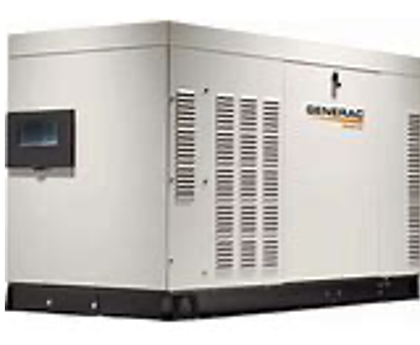
Emergency Generator
- In 2003 CFD received a grant to install an emergency generator
- Provides power to allow for CFD to be a regional shelter and to operate during power outages and other natural disasters
- Estimated annual cost of $800 for service
- In 2020 the generator cost ~$2000 in maintenance
- Estimated cost for new up-to-date more efficient 50KW generator is $15,000
Shared Services And Consolidation
- The Chatham Fire Department is comprised of two companies
– The Ocean Fire Company No. 1
– Sanford W. Smith Hook and Ladder - The companies are currently engaged in discussions to consolidate into one company
- There is little or no financial impact to the VOC regardless of the outcome of this effort although the consolidation may foster the administration of future shared services or divestment from the Village into an independent Fire District
Future Possibilities
- Firefighters from chiefs and administrative officers to rank and file firefighters ail agree the future of fire service involves the merger of departments
- CFD and Ghent Fire have engaged in conversations and focus groups to discuss the possibility of a future merger between both entities
– This is an undertaking of massive proportions - CFD has a long-standing history and working relationship with the Ghent Fire and plan to continue and expand the relationship whenever and wherever possible regardless of the results of any merger efforts
– Both companies engage in mutual training and drills, sharing apparatus, mutual purchasing agreements for apparatus and mutual grant applications
– For example, GFD recently purchased a tanker, which would be used for fires in areas that are not served by hydrants in Chatham’s area. In turn CFD would ensure we maintain a Ladder Truck and Engine that could be used in Ghent. - The potential future financial relief to Village and Town taxpayers over the course of the next decade could be significant should a consolidation of the companies be realized
- Other possibilities include
– Local or regional fire districts
– Joint purchasing agreements
– Career (paid) or combination paid/volunteer department
Summary of Future Capital Projects

Summary Of Suggested Actions By The Village Board
- Manpower/Volunteers
– Provide on-going annual funding tor Recruitment and Retention (media advertising, direct mail, top responder stipends, logo clothing, website, etc.) initially on the order of $2,500 - Facilities – The Chatham Fire Station
– Develop an RFP to engage an engineering or consulting firm to provide a facilities study with breakdowns of critical and non-critical items with cost estimates of each as well as a survey of the construction costs of newer, local fire stations - Apparatus
– Determine if the two older fire apparatus will be replaced and if so, in what time frame
– Decide if the addition of a Chief’s Command Vehicle is warranted and if so, how to obtain one - Equipment
– Plan for turnout gear purchase (approx. $85,000) in 2022-2024 if AFG grant is not awarded
– Decide if the emergency generator should be replaced or continue to be maintained as is - Shared Services and Consolidation
– Enter into discussions with Ghent and other local fire companies regarding jointly chartering a Master Plan study about the future possibilities for the fire service in our communities
Thank You
- We appreciate the Village Board granting us the opportunity to present this report for your consideration. If you have any questions, please feel free to contact the Chief at anytime.
- Chief Eric J. Barnes
- Chatham Fire Department
- 518-708-7105
- [email protected]
Appendix A – Facilities

- Detail of extreme corrosion to base of main I-Beams
- Outdated electric service panel
- Leaking plumbing fixtures
The Volunteers Maintain What We Have To The Best Of Our Abilities
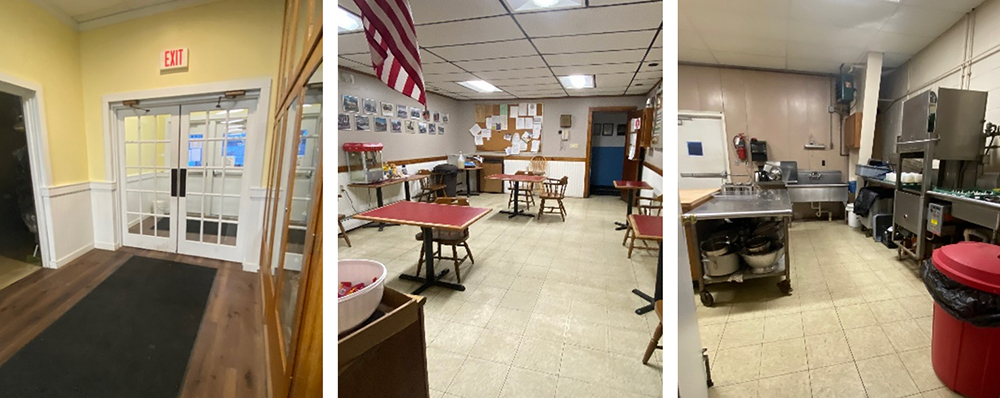
- Rear entrance
- Members’ meeting room
- Kitchen
Banquet Room
- Drills and training
- Company meetings
- Community functions
- Red Cross blood drives

Main Hallway
- Offices on left, restrooms on right

Equipment Bays
Appendix B – Apparatus
- The next three pages of this appendix relate to a Command Vehicle
- The remainder of the appendix describes the maintenance issues that are of concern regarding the two pieces of apparatus (Engine 58-21 and Rescue 58-46) whose disposal is being recommended
- Included is a general description of the characteristics of a single piece of apparatus to replace the two above
- There are suggestions as to how to dispose of the two, estimates of their potential sale value, and possible ways of acquiring the new equipment at the lowest cost
Chief’s Use of POV
- In 2019, Car 1 responded to 80 of the 125 calls for service.
- Add the trips made to the training tower, board and county/fire chief meetings, fire department drills, trips to Garrison Fire Equipment in Palenville, NY, etc. Imagine the cost to one’s personal accounts for fuel, wear and tear and related maintenance.
- Thankfully there have been no accidents or liability claims to POV’s in recent years, but the potential exists.
- CFD proposes that the VOC research and start a fleet purchase and replacement plan
- Initially, the investment could range from transferring existing vehicles within the VOC fleet to the CFD for use, to purchasing a used SUV (similar), to making the investment into purchasing a new(er) Command Vehicle
- Recent research has revealed used vehicles of similar nature could be purchased for between $10,000 and $25,000
- State contract purchase of a new vehicle would be similar to a police vehicle
– Used Command & Chief Vehicles For Sale | Fenton Fire
– Used Fire Command Units (firetruckmall.com)
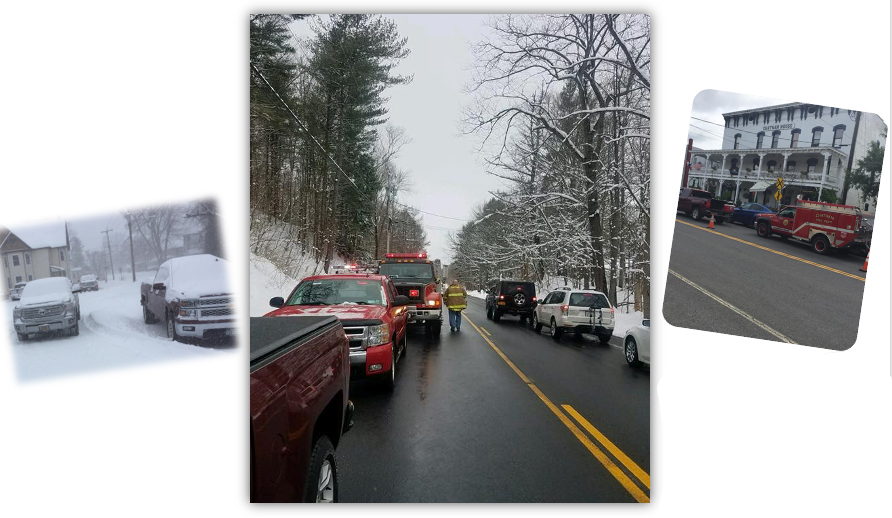
POV’s are shown in traffic at an accident, hauling coolers and operating at a fire alarm. Chiefs respond to every type of call you can imagine
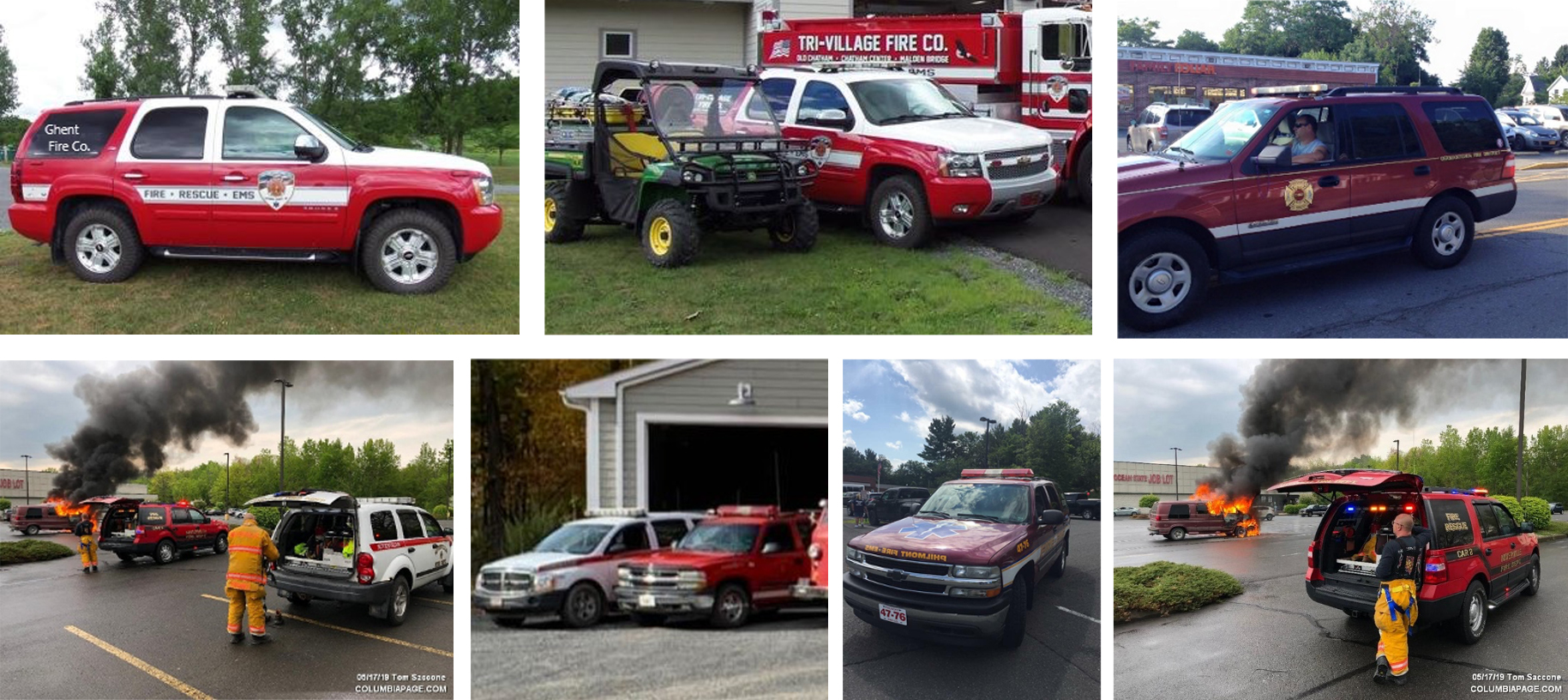
Local Departments’ Command Vehicles
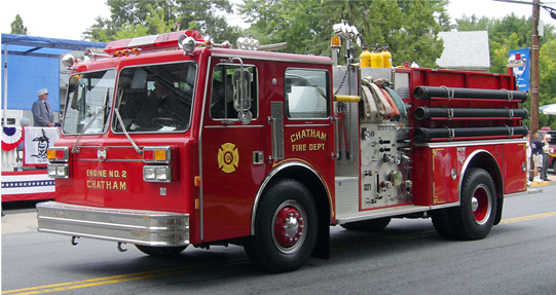
Potential Future Maintenance Items – Engine 58-21
- Body Materials.
– As this unit is constructed primarily of a 1/8th inch aluminum body and a plain steel subframe and pump house framework corrosion starts to play a significant role.
– The newer materials used to pre-treat the roads during the winter months aggressively attack these materials degrading the structural integrity of those items constructed of aluminum and plain steel.
– Even with an aggressive washing regimen the pre-treat materials are impossible to remove inaccessible areas e.g., between the frame rails, between the springs etc. causing unseen damage - Water Tank
– The water tank is constructed of untreated steel. As with any item constructed of steel, prolonged contact with water will cause corrosion. As this vehicle is 28 years old the chances for leakage from welds or thinning of the materials increase.
– In addition to leakage overall structural integrity (including tank baffles) may be reduced with age.
– If the water tank were to fail:
•A new poly tank would cost approximately $12,000.00
• Because the existing sub-frame/tank cradle was not designed for a newer style poly tank a new tank cradle would have to be constructed, a cost of approximately $7,500.00
• A total cost of almost $20,000.00 - Fuel Tank
– As the fuel tank and supporting straps are made of steel the likely hood of exterior corrosion issues, it is expected that these items will need to be replaced to prevent the tank from dropping out.
– With the introduction of the lower sulfur fuels interior tank issues (agley, corrosion etc.) are becoming more prevalent. These items could lead to poor engine performance, fuel blockage etc.
– To replace the fuel tank and accessories would cost us approximately $3,000.00 - Availability of replacement parts
– As the unit is almost 30 years old the ability to replacements parts for the unit diminishes. For example, the emergency warning system is obsolete. If the main light bar were to cease functioning a replacement light bar would cost us approximately $2,000.00 for the light itself not including labor.
– Manufactures across the board are no longer stocking items as they did in the past. On average the Akron Brass Company (the people who make the valves for the fire pump) have an eight (8) week lead time for current offerings. If we were to need items that have been discontinued, we would need to either have the item recast or retrofit an existing model to make the needed repair. Either of these actions would mean delays in repairing the unit. - The aforementioned items are items that we could easily identify. Like a car or pick up truck, the older they get the more apt they are to have issues. Unfortunately, in our business issues are not compatible with our mission statement of protecting lives and property.
- We did not identify potential issues with the electrical systems, transmissions, etc. That list would be exhaustive. With all of this said we are not saying that these items will happen, but the likelihood of mishaps are increasing.
Cost Of New Apparatus to Replace 58-21 and 58-46
- Why the increased cost?
– In speaking with a local sales rep, there used to be on average a 2-3% increase in cost every year, unfortunately this is out the window. One manufacturer had a 9% increase in 16 months between FY 2019 and FY 2020 on just the cab and chassis.
– Increased cost in materials (import tariffs and the like)
– NFPA and EPA mandates. For example, with the release of the 2016 edition of NFPA 1901 (NFPA Standard for Automotive Apparatus) an added expense of approximately $1,800.00 worth of warning labels have been added to the apparatus, the cost of these labels increases with the different options added to the vehicle.
– Normal increase in operating expenses (health care, utilities etc.)
– There is a guarantee of one price increase every year, although it is more common to see 2 increases a year. Sometimes the increases are nominal other times extraordinary.
National Fire Protection Association (NFPA) 1901 Appendix D
- D.1 General. To maximize fire fighter capabilities and minimize risk of injuries, it is important that fire apparatus be equipped with the latest safety features and operating capabilities. In the last 10 to 15 years, much progress has been made in upgrading functional capabilities and improving the safety features of fire apparatus. Apparatus more than 15 years old might include only a few of the safety upgrades required by the recent editions of the NFPA fire department apparatus standards or the equivalent Underwriters Laboratories of Canada (ULC) standards. Because the changes, upgrades, and fine tuning to NFPA 1901 have been truly significant, especially in the area of safety, fire departments should seriously consider the value (or risk) to fire fighters of keeping fire apparatus more than 15 years old in first-line service.
- It is recommended that apparatus more than 15 years old that have been properly maintained and that are still in service‐ able condition be placed in reserve status; be upgraded in accordance with NFPA 1912; and incorporate as many features as possible of the current fire apparatus standard (see Section D.3). This will ensure that, while the apparatus might not totally comply with the current editions of the automotive fire apparatus standards, many of the improvements and upgrades required by the current editions of the standards are available to the fire fighters who use the apparatus.
- Apparatus that were not manufactured to the applicable NFPA fire apparatus standards or that are over 25 years old should be replaced.
Specifications Of New Apparatus To Replace 58-21 And 58-46
- While we haven’t formally sat down as a group to layout the details of what a unit would have, we did outline the basics:
– 6-man cab with 10 inch raised roof
– 450 Cummins,
– Stainless Steel Rescue Style Body with 3 10 ft suction and ladders thru the tank
– Front suction, 2 1/2 discharge on front for 200 ft 1 3/4 trash line
– 1500 gpm hale pump with a class A foam system
– Usual discharges with 3 in rear discharge
– 1000-gallon tank
– Manual deck gun
– 1000 ft of 5” and 300 ft 3”
– “Coffin compartments” – large storage compartments
– 10 kw generator with cord reel
– Body scene lights, brow light. Rear scene lights and pole mounted lights on pump panel
Procurement Of New Apparatus To Replace 58-21 and 58-46
- We have identified a recently new method (within the last 10 years) for buying fire apparatus, Cooperative Purchasing. There are several Government Contracts that allow municipalities and non-profits to purchase everything from copiers to backhoes. In talking with other Chiefs, the following two Cooperatives seem to be the most prevalent
– HGACBuy https://www.hgacbuy.org/about
– Sourcewell Cooperative Procurement & Contract Purchasing I Sourcewell (sourcewell-mn.gov) - After some research and discussions with other Agencies we came away with the following:
– Both Cooperatives are Government Entities
– Because they are Government entities, they follow similar bidding processes and legalities as found with any other Government purchasing rules and regulations
– Both Cooperatives solicit bids through a competitive process.
– NY alone has 462 end users with HGACBuy , to include larger cities such as Buffalo, Rochester, Saratoga, and Yonkers, and smaller users such as Claverack Fire Dist., Livingston Fire Dist., and Dutchess County
– NY Sourcewell end users total 2,407 and include the Ancram Fire Dist., Town of Lebanon, Craryville Fire Dist., Town of Mellenville, Ghent Highway, Town of Kinderhook, AND THE VILLAGE OF CHATHAM!
Procurement Of New Apparatus – Cooperative Purchasing
- Benefits of Cooperative Purchasing:
– Variety of vendors. Upon a quick look through the list of vendors for both we found that all the major manufacturers were represented allowing us to vet and decide on a builder without limiting our choices.
– Because the Cooperatives have already bid the contract, it would save us a ton of time. We wouldn’t have to prepare a technical document, solicit bids, review and compare proposals, and then contract. The quickest we could possibly do this would be about 180 days (not considering the current COVID-19 environment).
– Possible savings. As we would be spending time with one vendor in designing the vehicle and not going through the bid process, we would save time and avoid possible price increases. We have been told that some vendors offer discounting using Cooperative Purchasing (as we haven’t officially met with a vendor yet, we have not substantiated this).
– Ensuring we get the vehicle that we require.
– There are no costs to be a member of either Cooperative and can be used to purchase a variety of items for the different services the Village provides.
Procurement of New Apparatus
- Cooperative Informational Links:
– 4HGAC End Users List of HGACBuy End Users | HGACBuy
– HAGC and State Statutes Authorizing State Statutes | HGACBuy
– How to join HGAC How to Become an End User | HGACBuy
– Sourcewell Legal Authority & Compliance for Cooperative Purchasing I Sourcewell (sourcewell-mn.gov)
– Sourcewell End Users Member Lookup: Search Sourcewell Members by Name | Sourcewell (sourcewell-mn.gov)
– Sourcewell Contract look up Search Sourcewell Awarded Contracts & Vendors | Sourcewell (sourcewell-mn.gov)
Disposal Of Apparatus – Pro’s And Con’s
- Direct sale by the Department
– Would require a good deal of effort on our part without access to marketing. However, we retain all funds from the sale. - Use a broker
– Would allow immediate and large market exposure reaching the entire used apparatus market. The sell price would be based on a combination of our asking price and market value of similar units. A brokers’ fee would be paid upon sale of the apparatus, usually between 5 and 10%. - Third party vendor
– This would be the easiest way to dispose of the apparatus. The vendor would make an offer, cut us a check, and take the vehicles. The downside is that the offer would most likely be less than market value as the vendor may need to perform services, inspections, and make a profit. - Trade In
– This would be the second easiest way, but as noted above the offers would be low as the dealer/manufacturer would then have to dispose of the apparatus. There is also a possibility that the price of the new truck could go up to offset possible losses from the used units.
Estimated Value Of Existing Apparatus
- Although we have not made any direct inquiries about the value of our apparatus, we did utilize the internet to get a handle of what similar vehicles are selling for using the following venues:
– https://www.firetruckmall.com/
– https://www.fentonfire.com/
– http://www.firetec.com/
– While we were not able to find vehicles that matched exactly, we did find units of similar age and scope. - Value of 58-21. With the thought that our units wouldn’t be ready for disposal until 3rd quarter 2022, the engine would be almost 30 years old with very little value
– After looking at similar vintage units the range was large with some units have an asking price as low as $8,000 and as high as $60,000. However, the average asking prices were between $18,000 and $35,000.00.
– We identify that having a steel tank and being in the Northeast will be a hindrance in asking top dollar. - Value of 58-46. Again, finding exact matches proved difficult. The average range was between $25,000 and $40,000. As part of a detailed inspection in January 2021, the retail value of the vehicle was estimated as $35,000.
- Worse case scenario we could receive approximately $43,000 for both, best case scenario $75,000 for both. In any scenario we expect the Rescue to receive the higher return.
- For reference when we replaced the 1988 Maxim with the 2016 Rosenbauer, we received $5,800 for the sale. The Maxim was the same age as 58-21 is now.
- If the project receives approval to move forward, we can reach out directly to receive estimates.
Appendix C – Equipment
Operational Budget Showing Budgeted Equipment Expense
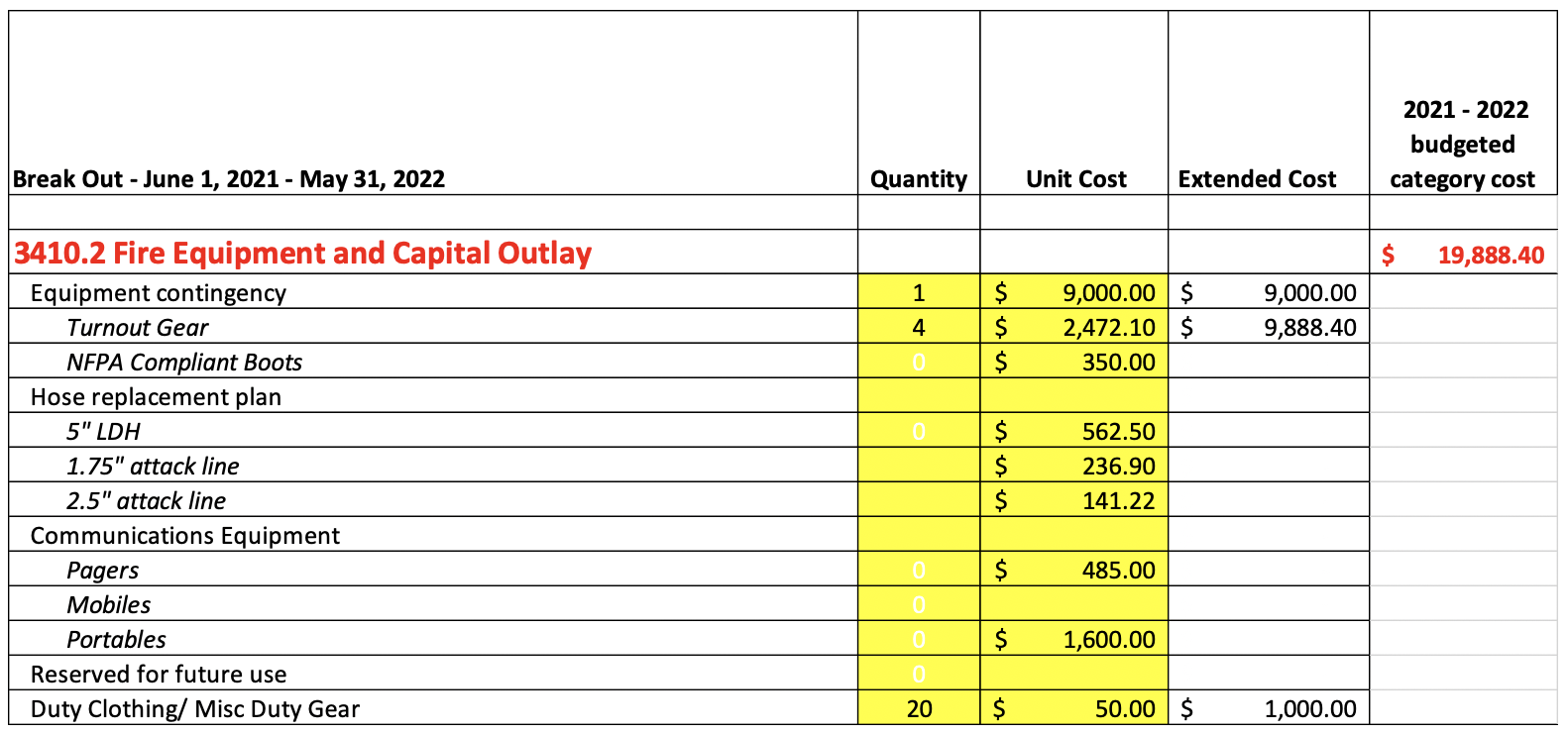
Appendix D – Shared Services And Consolidation
Master Plan Studies
Fire Service Consolidation Study
Master Plan Study
- The Village should consider employing a consulting firm, such as, but not limited to Dynamix Consulting Group
- A complete look at a Scope of Work proposal created by Dynamix for the Village.

